A properly maintained polyurethane foam roof will provide excellent insulation, save money on energy consumption all while protecting your building and its contents against nature’s extremes. That is why it is so important to periodically inspect your roof for damage or defects on a regular basis. It is recommended that you inspect your roof at least twice a year, once in the spring and once in the fall.
Gutters, Scuppers & Drains

-
Check all drains, scuppers, and gutters for leaves, dirt, etc., that can block positive drainage.
-
Check the seal of the system around these areas.
-
Verify that screens and strainers are in place.
Inspect Rooftop Units & Penetrations
-
Roof penetrations such as vents, hatches, stacks, skylights, and HVAC equipment should be sealed against the weather.

-
Condensation from HVAC units should be piped to drains. Insure that stacks have rain caps, seams in units are sealed with caulk, skylights are properly sealed, and there has been no damage to the surrounding roof system.
Inspect Flashings, Roof Edges, Expansion and Control Joints and Other Roof Systems Terminations
-
Look for cracks or splits in the system at roof terminations such as edge flashings and expansion joints.
-
Ensure that coping joints and metal flashings are sealed.
-
Check masonry walls for moisture penetration and/or deterioration.
The Field or Surface Area of the Roof System

-
-
Check for mechanical or physical damage caused by tools or heavy objects, hail, vandalism, excessive foot traffic, etc.
-
-
Inspect for blisters or areas of inner layer separation in the roof system.
Defects in the Roof Surface

-
Check for pinholes, erosion of the coatings or polyurethane foam, cracks, and moisture penetration into the polyurethane foam insulation. A small “slit” sample may be taken to determine if there is any moisture present. A non-destructive moisture detection device may also be used.
Not sure what to look for while inspecting your roof? Click here to download one of our roof inspection guides so you don’t miss anything. If you still aren’t confident in inspecting your roof then give us a call and one of our trained professionals will assist in the inspection!


